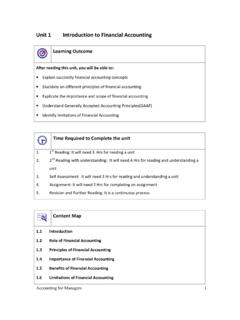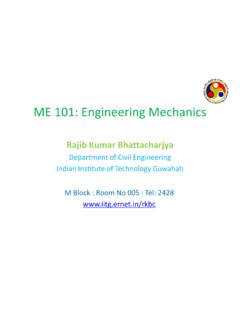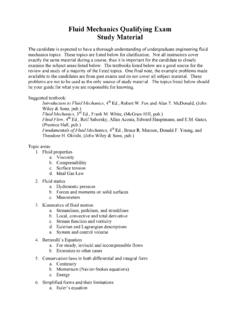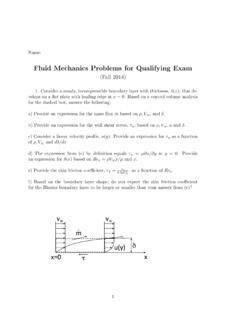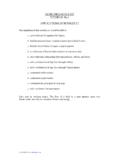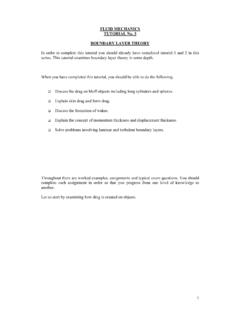Transcription of Fluid Mechanics: Stokes’ Law and Viscosity
1 Measurement Laboratory No. 3 EGR 1011 Fluid mechanics : Stokes Law and ViscosityMeasurement LaboratoryInvestigation No. 3 Scott A. Shearer, ProfessorJeremy R. Hudson, Graduate Teaching AssistantBiosystems and Agricultural Engineering1. IntroductionThis laboratory investigation involves determining the Viscosity and mass density ofan unknown Fluid using Stokes Law. Viscosity is a Fluid property that provides anindication of the resistance to shear within a Fluid . Specifically, you will be using afluid column as a viscometer. To obtain the viscometer readings you will use astopwatch to determine the rate of drop of various spheres within the Fluid . You willdetermine both density and Learning OutcomesOn completion of this laboratory investigation students will: Appreciate the engineering science of ' Fluid mechanics .
2 ' Understand the concept of Fluid ' Viscosity .' Understand the concept of dimensionless parameters, and most specificallythe determination of Reynold's Number. Be able to predict the settling time of spheres in a quiescent Fluid . Be able to calculate the Viscosity of an unknown Fluid using Stokes' Law andthe terminal velocity of a sphere in this Fluid . Be able to correct for the diameter effects of Fluid container on thedetermination of Fluid Viscosity using a 'falling ball' DefinitionsFluid a substance that deforms continuously when subjected to a shear a Fluid property that relates the shear stress in a Fluid to the angular rate mechanics the study of Fluid s Number dimensionless parameter that represents the ratio of viscous toinertial forces in a Laboratory No.
3 3 EGR 10124. Stokes LawFigure 1: George Gabriel StokesGeorge Gabriel Stokes, an Irish-born mathematician, worked most of his professionallife describing Fluid properties. Perhaps his most significant accomplishment was thework describing the motion of a sphere in a viscous Fluid . This work lead to thedevelopment of Stokes Law, a mathematical description of the force required tomove a sphere through a quiescent, viscous Fluid at specific velocity. This law willform the basis of this laboratory ' Law is written as,VdFdpm6=where Fd is the drag force of the Fluid on a sphere, m is the Fluid Viscosity , V is thevelocity of the sphere relative to the Fluid , and d is the diameter of the sphere. Usingthis equation, along with other well-known principle of physics, we can write anexpression that describes the rate at which the sphere falls through a quiescent,viscous be begin we must draw a free body diagram (FBD) of the sphere.
4 That is we mustsketch the sphere and all of the internal and external forces acting on the sphere as itis dropped into the Fluid . Figure 2 shows a sketch of the entire system (spheredropping through a column of liquid). The FBD is the dashed cross-section that hasbeen removed and exploded in the left portion of this Laboratory No. 3 EGR 1013 Figure 2: Free-body diagram of a sphere in a quiescent FBD in this figure lists three forces acting on the sphere; Fb, Fd, and mg. Thefirst two forces arise from the buoyancy effect of displacing the Fluid in question, andfrom the viscous drag of the Fluid on the sphere, respectively. Both forces actupwards -- buoyancy tending to 'float' the sphere (Fb) and the drag force (Fd)resisting the acceleration of gravity.
5 The only force acting downwards is the bodyforce resulting from gravitational attraction (mg). By summing forces in the verticaldirection we can write the following equation,mgFFdb=+The buoyancy force is simply the weight of displaced Fluid . As you may recall fromearlier work in science and math, the volume of a sphere (vsphere) is written as,334rvspherep=Combining this volume with the mass density of the Fluid , rfluid, we can now write thebuoyancy force as the product ,grgmFfluiddfbrp334==where g is the gravitational acceleration and r is the radius of the sphere. Combiningall of the previous relationships that describe the forces acting on the sphere in a fluidwe can write the following expression,mgFdFbMeasurement Laboratory No. 3 EGR 1014mgVdgrfluid=+pmrp6343 Rearranging and regrouping the terms from the above equation we arrive at thefollowing relationship,()mrr922grVfluidsphere-=Whi le Stokes Law is straight forward, it is subject to some limitations.
6 Specifically,this relationship is valid only for laminar flow. Laminar flow is defined as acondition where Fluid particles move along in smooth paths in lamina ( Fluid layersgliding over one another). The alternate flow condition is termed turbulent latter condition is characterized by Fluid particles that move in random inirregular paths causing an exchange of momentum between utilize a dimensionless parameter known as the Reynold s number todistinguish between these two flow conditions. This number is a ratio between theinertial and viscous forces within the Fluid . Engineering students will learn moreabout the origin of this parameter the Buckingham Pi Theorem in the final twoyears of the curriculum. For now we will define the Reynold s number as,mrVdNR=where NR is Reynold s Number, rfluid is the mass density of the Fluid , V is the velocityof the fluids relative to the sphere, and d is the diameter of the application of the Reynold s Number to fluids problems is to determine thenature of the Fluid flow conditions laminar or turbulent.
7 For the case where wehave a viscous and incompressible Fluid flowing around a sphere, Stokes Law isvalid providing the Reynold s Number has a value less than When utilizingStokes Law, it is appropriate to verify the application of this law is Falling Ball ViscometersThe falling ball viscometer is based on Stokes Law, and is what we will use in thislaboratory investigation. This type of viscometer consists of a circular cylindercontaining the Fluid and a smooth ball. The ball is placed in the Fluid and the time thatit takes to fall the length of the cylinder is recorded. This time is then utilized to backthe Viscosity out of the velocity relationship that we derived using Stokes Law andsumming forces. As the ball is dropped into the Fluid it accelerates as a result of thegravitational field until the ball reaches terminal velocity.
8 Terminal velocity occursMeasurement Laboratory No. 3 EGR 1015when the viscous and buoyancy forces equal the weight of the ball. At this point thevelocity of the ball is maximum, or terminal. To simplify our approach, we will allowthe ball to reach terminal velocity prior to making the time Laboratory ProceduresPart I: Determine the Viscosity of an unknown fluid1) At your lab station you will find several different sizes of spheres of differentmaterials. The materials are brass, Teflon, and glass. For the first procedure youneed to use the largest of the Teflon ) Using the micrometer determine the diameter of the largest Teflon sphere to thenearest inch. You must convert this measurement to SI units (Hint: cm.) Next using the digital scales, find the mass of the Teflon sphereto the nearest g.
9 You can now use these two numbers to determine thedensity of the Teflon sphere (g/cm3).3) Next you will need to measure the fall time of the sphere through the Fluid in the2000-mL graduated cylinder (to the nearest s). To do this use the stopwatchto measure the amount of time it takes for the sphere to fall from the 1600-mLmark to the 400-mL ) Repeat steps for the remaining two Teflon spheres of that ) Measure the distance using the ruler between the 1600-mL graduation line and the400-mL graduation ) Now using the time recorded from the stopwatch for each sphere dropped and thedistance measurement between the graduation lines, determine the velocity ofeach sphere as it passed through the Fluid (cm/s). You will need to use the steelscale to determine the distance between the 400 and 1600 ml marks7) Using Stokes Law provided in the lab manual, determine the Viscosity (m) of thefluid using the average velocity of the three spheres.
10 A common unit of viscosityis the Poise, or 1 ) Calculate the Reynold s Number using the Fluid and ball properties II: Predict the fall time of similar size spheres of differing materials:1) Using the micrometer, determine the diameter of the largest glass and brassspheres (nearest in.). There should be three of each and these diametersshould be roughly the same as the diameters of the Teflon spheres used Laboratory No. 3 EGR 10162) Next use the digital scales to determine the mass of each of the spheres ( g). Using the mass and diameter measurements, calculate the density of theglass and brass spheres (g/cm3).3) Now using your calculated Viscosity for the unknown Fluid , use Stokes Law todetermine the velocity for the spheres (cm/s). Using the velocity and the distancebetween the 1600-mL and the 400-mL graduation lines determine the fall time forthe ) Next confirm your predicted fall times by timing each of the spheres fallingthrough the III: Predict the fall time of differing size spheres of similar material 1) Determine the diameters of the remaining six glass spheres.
